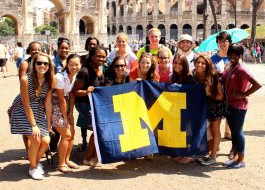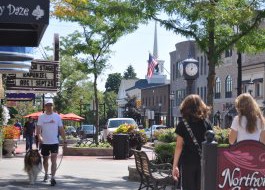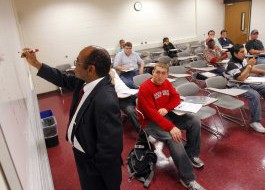
DECEMBER 17, 2016 KALAMAZOO, MICH.—Tracy Zarei has wanted to teach children ever since she was in the second grade. She knew she would have to go to college to become a teacher.
“She was a straight-A student,” says her mother, Sheri, who was working double shifts in a nursing home to pay rent on their mobile home. “She cried when she got her first B.”
Then one day Tracy’s world shifted. When her mother returned home from work, Tracy handed her a note. “She said, ‘Mom, you’re going to be disappointed,’ ” recalls Sheri, who thought it must be a traffic ticket. Instead it was a positive pregnancy test. Antonio Jr. was born in March 2005. Tracy was a junior in high school.
For many teenage mothers, this is when school ends and hardship begins. By age 22, only half of all single mothers in the United States receive a high school diploma, compared with 90 percent of their peers.
With her mother’s help, Tracy went back for her senior year. Money would be tight, but perhaps she could enroll in community college, work her way toward a teaching certificate – and defy the stereotyped limitations of being a teen parent. “I couldn’t just be another statistic,” she says.
That fall, the trajectory of Tracy’s life veered again. At a school board meeting in November 2005, then-Superintendent Janice Brown announced that a group of anonymous donors had agreed to pay for up to four years of college tuition for most students in the district who graduated that year – and for all future classes.
 Laquetta Smith, right, gives a congratulatory hug to Lauryn Scott, after the Kalamazoo Central High School graduation ceremony Wednesday, June 7, 2006, at Wings Stadium In Kalamazoo, Mich.AP/Mark Bialek
Laquetta Smith, right, gives a congratulatory hug to Lauryn Scott, after the Kalamazoo Central High School graduation ceremony Wednesday, June 7, 2006, at Wings Stadium In Kalamazoo, Mich.AP/Mark Bialek
The Kalamazoo Promise, one of the most generous scholarships of its kind, had begun in this city of 75,000, a former manufacturing hub fallen on Dickensian hard times.
Today, 11 years later, it remains one of the most ambitious education and social experiments in the nation – a test of how far private money can go in reviving a city. It has tried to do so not by investing in some trendy new industrial park but in young people themselves, creating an educated generation for the knowledge economy. It’s a vision of a college-going culture that can be the balm for income inequality and recipe for Rust Belt renewal.
The idea, says Ms. Brown, who is now a trustee of the scholarship, is to change the lives of young people first and the community second. “It’s a transformative movement,” she says.
To a large extent, it’s working. The Promise has helped revive Kalamazoo’s public schools, sent hundreds of kids to college who normally wouldn’t have gone, and pumped new vitality into the city. But the experiment has also taken longer to reap benefits than many expected and exposed deeper social problems, spurring changes in the city’s approach.
The lessons Kalamazoo has learned are important. Since the program began, at least 90 school districts and cities have started their own version of free-tuition programs using public and private money, though few are as generous or universal as Kalamazoo’s. Oregon, Tennessee, and Minnesota now offer promise programs for residents who want to go to community college. California is poised to start something similar.
Kalamazoo’s model may become even more crucial in the future. As college tuition rates inexorably rise, and education becomes the hard drive of the economy of tomorrow, everyone is looking for ways to expand the number of people getting degrees. The question is whether Kalamazoo has found a formula that really is transformative – for it and for other cities around the country.
 Via Wikimedia Commons
Via Wikimedia Commons
Some of the answers lie in the arc of Tracy Zarei’s life.
In the first years of the program, college attendance surged. Not all students were eligible for the scholarship, which covers between 65 percent and 100 percent of tuition for public school students who enroll between kindergarten and ninth grade. (The cutoff is designed to discourage late transfers.)
But of the 2006 class of 519 graduates, 4 out of 5 were eligible. A year later, 83 percent of those students had started college, compared with an average of 60 percent at high schools in similar urban districts across the country. Overall, more than 4,500 students have received scholarships in the 11 years since the program began, and the city’s graduation rate has climbed.
Still, some students have struggled to reap the full benefits, dropping out midway through their studies and thus failing to earn a degree. Going to college isn’t the same as graduating from college. For Kalamazoo’s best and brightest, the scholarship has been a first step toward an Ivy League degree, internships at Goldman Sachs, or the White House. But most students’ experiences are more like that of Tracy, who graduated in 2006. She used her money to attend a school closer to home – Western Michigan University, in Kalamazoo.
It took her six years to earn a bachelor’s degree. The Promise covered 75 percent of her tuition since she had attended a charter school for middle school (the program doesn’t underwrite charter school students). So she worked part-time as a waitress, trying to juggle classes and child care, falling behind at times, going into debt. “The hardest thing in college was homework,” says Tracy.
 Alex Plair Jr. gets a congratulatory kiss from his neighbor Irene Ryan while showing his diploma after his Kalamazoo Central High School graduation ceremony on Wednesday, June 7, 2006, at Wings Stadium in Kalamazoo, Mich. Looking on in the background is his father, Alex Plair. AP/Mark Bialek
Alex Plair Jr. gets a congratulatory kiss from his neighbor Irene Ryan while showing his diploma after his Kalamazoo Central High School graduation ceremony on Wednesday, June 7, 2006, at Wings Stadium in Kalamazoo, Mich. Looking on in the background is his father, Alex Plair. AP/Mark Bialek
Then, in her third year of college, her daughter, AnTiana, was born. Antonio, the father of both children, drifted in and out of their lives. Tracy took a lighter course load each semester, but refused to give up.
In 2012, Tracy graduated from Western – something she is convinced she would never have been able to do without the Promise. “There would’ve been a point where I couldn’t continue,” she says.
A 2015 study by the W.E. Upjohn Institute for Employment Research compared the educational attainment of students like Tracy, who received the scholarships, with the Kalamazoo high school graduates who preceded them. According to Timothy Bartik, coauthor of the study, the percentage of students receiving a college degree or certification jumped several points, and more of those graduating were low-income and minority students.
His team calculated that for every $1 invested in a Kalamazoo student’s college education, he or she can expect to earn on average more than $11 over the course of a career. So far, the Promise has paid more than $85 million in scholarships.
Higher education offers a return that few other investments can match. Studies show that college-educated workers not only can expect to earn more money, but usually experience better health and live longer lives.
 Stephanie Butler, 19, uses flash cards as summer school students Esbeydi Soria Parra, left, and Ramsey Prieto, right, sound out the word at Woods Lake Elementary School Monday, Aug. 6, 2007, in Kalamazoo, Mich. Butler, a junior at Michigan State University this fall was among the first students to benefit from The Kalamazoo Promise, an anonymously funded free-tuition program for graduates of the district's high schools. AP/Shawano Cleary
Stephanie Butler, 19, uses flash cards as summer school students Esbeydi Soria Parra, left, and Ramsey Prieto, right, sound out the word at Woods Lake Elementary School Monday, Aug. 6, 2007, in Kalamazoo, Mich. Butler, a junior at Michigan State University this fall was among the first students to benefit from The Kalamazoo Promise, an anonymously funded free-tuition program for graduates of the district's high schools. AP/Shawano Cleary
The benefits redound to communities as well. William Moses, director of education at The Kresge Foundation in Troy, Mich., notes that regions with large pools of educated workers recovered much faster after the last recession and are more attractive to educated youth and the companies that employ them.
“If a city can build its own timber by getting more local college graduates, it can be a huge economic development tool,” Mr. Moses says.
When Bob Ezelle first heard about the Promise, he didn’t know what to make of it. As the executive director of the Boys & Girls Club of Greater Kalamazoo, which runs after-school centers in the city’s roughest neighborhoods, he knew that students needed all the help they could get. Mr. Ezelle also understood the social uplift of a college degree. An African-American orphan who never knew his parents, he won a football scholarship to Western Michigan that put him on a career track.
But who would be helped by the program the most – poor minority families who could barely feed their kids, or middle-class households who already had their eye on college and whose kids would now get a debt-free ride to a degree?
“At first I said, ‘I just can’t see, if the kids are doing bad at school, how this is really going to benefit them,’ ” says Ezelle. “Their parents are still looking at their basic needs. [College] isn’t a priority at this point. They’re doing their best to keep their kids out of trouble.”
Unlike federal student aid, the Promise doesn’t provide money based on the ability to pay. It’s a universal program that underwrites rich and poor students alike, whether they enroll in a local community college or a selective four-year program. It even matches tuition at private in-state colleges up to the amount charged by the most expensive public university. Students are free to take the money and not come back after college, taking their degree and talents with them.
“It’s not a social program,” says Brown, the trustee. “We want all students to have the advantage.”
The simplicity of the program is part of its appeal: no confusing application forms, no test-score cutoffs. Eligible students get the scholarship money regardless of other grants or loans they receive. This is an effective way to improve access for low-income students who are deterred by what they perceive as the high cost of college, as well as the uncertainties of financial aid, says Robert Archibald, an economist at the College of William & Mary in Williamsburg, Va.
 Alex Plair II, 18, of Kalamazoo, left, a sophomore at Western Michigan University, participates in a weekly Bible study on campus, Thursday, Aug. 3, 2007, in Kalamazoo, Mich. AP/Shawano Cleary
Alex Plair II, 18, of Kalamazoo, left, a sophomore at Western Michigan University, participates in a weekly Bible study on campus, Thursday, Aug. 3, 2007, in Kalamazoo, Mich. AP/Shawano Cleary
Most high school students can’t explain how a Federal Pell Grant works, but readily grasp a Promise-style scholarship. “People know what it is because it’s one sentence,” says Mr. Archibald, coauthor of “Why Does College Cost So Much?”
For Kalamazoo, the program has become part of its identity, a way to stand out in the crowd. “Home of The Promise, 2005,” reads the sign on the edge of town, the same message that greets visitors at the airport. Other cities declare themselves open for business or tourism. Kalamazoo wants you to know that it’s funding knowledge.
Many residents talk about the Promise with almost angelic reverence. And there is a widespread sense that the generosity of the donors needs to be matched by a commitment from the city as a whole not to let the experiment fail.
“It changes the perception of Kalamazoo as yet another dying, cold Midwest urban center into a place that’s pretty cool,” says Michelle Miller-Adams, a research fellow at the Upjohn Institute who has written two books on the Promise.
Kalamazoo still looks like a Rust Belt city – one that used to make everything from Checker cabs to Gibson guitars. The city’s urban core is a work in progress. There’s a new medical school downtown and a new community college campus that just opened this fall. But the pockets of affluence, including modern hospitals and the university, are not far from streets of weathered wooden houses with sagging porches and boarded windows. New restaurants and stores have opened downtown, and young people are moving in, but seem outnumbered by the discount chains and storefront churches, particularly when you cross the freight train tracks.
This is the other reason why the Promise is for all students, regardless of income: Kalamazoo is desperate to hang onto its largely white middle class and prevent its schools from succumbing to de facto segregation, as in other hollowed-out cities. Half the student body is African-American, and 7 in 10 students qualify for subsidized lunches.
In the long run, Kalamazoo hopes that the Promise, and its spin-off economic effects, can attract more middle-class families and undergird an urban renaissance.
“If you want the system to change, the community to change, the schools to change, you don’t want to say this is for poor children,” says Ms. Miller-Adams, whose own daughter attends middle school.
 Justin Hatfield, Kalamazoo Central High School Student Council president, gives his speech during a graduation ceremony Wednesday, June 7, 2006, at Wings Stadium in Kalamazoo, Mich. AP/Mark Bialek
Justin Hatfield, Kalamazoo Central High School Student Council president, gives his speech during a graduation ceremony Wednesday, June 7, 2006, at Wings Stadium in Kalamazoo, Mich. AP/Mark Bialek
Affluent, educated parents are more likely to get involved and press for school improvements that benefit all students, not just their own.
The effect on the city’s public schools has been noticeable. Kalamazoo is now the fastest-growing school district in the state. More students means more state funding to turn around schools and extra services that can drive up graduation rates.
Seven out of 10 students in Kalamazoo now graduate from high school, though that is still below the national average of 83 percent. And barely half of black males get a diploma, compared with 77 percent of black females, who are also attending college in higher numbers. Michael Rice, Kalamazoo’s school superintendent, calls that “a profound achievement gap,” one Kalamazoo is tackling with various initiatives, including an expanded mentoring program for male students.
These are the at-risk kids that Ezelle has spent his career trying to support. He’s come around to the idea of the Promise as an engine of community change, geared to college as a goal for all. “As a black man, without a college degree I would not be in the position I’m in today, to have an impact positively on the lives of young children,” he says.
From Monday to Thursday, Gregory Socha dons the kind of dowdy gray suit and jaunty tie that you’d expect an elementary school principal to wear. Fridays are different. In Kalamazoo, Fridays are Promise days. Teachers come to school in their college T-shirts and talk to students about what it means to be ready for college and why the Promise matters. Mr. Socha, a California transplant who has taught in Kalamazoo for 20 years, wears a dark green T-shirt emblazoned with the word “Promise.”
Come spring, fourth- and fifth-graders at Arcadia Elementary School will learn about different careers and the importance of college as a springboard. They will visit the nearby Western Michigan campus so that it starts to feel familiar. The pattern repeats itself as students move on to middle school and to high school.
Inside a sun-splashed second-grade classroom, where students sit four to a table copying “sentence starters” from a whiteboard, Loralynn, age 7, exudes sass and ambition. “I want to be the president,” she says, brown eyes flashing below bunched curly hair. Asked about the Promise, she doesn’t hesitate. “We get to go to college for free.” Mianna, 7, an aspiring fashion designer, nods. She says her mom wants her to go to college because she never had the chance to.
 Wikimedia Commons / mxobe
Wikimedia Commons / mxobe
If that sounds young for college prep, try this: Kalamazoo just introduced a pledge addressed to “the college-going class of 2029.” At kindergarten parent-teacher conferences this fall, families were asked to sign a certificate that had been cosigned by Dr. Rice and Robert Jorth, executive director of the Kalamazoo Promise. Each parent/guardian promised to:
•Talk with my child about school every day.
•Listen to my child’s dreams about his or her future.
•Prepare today: Read together and help with homework every night.
•Attend parent-teacher conferences and school events.
•Plan for college with my child.
•Be a positive role model.
For children whose parents didn’t attend college, earning a degree is as much a mind-set as a matter of good grades. That’s why all the positive reinforcement, from class mascots named for college teams to teachers posting their own credentials on the classroom door, starts early in Kalamazoo. “It all ties back to the Promise. We’ve got an opportunity, a chance, a gift,” says Socha.
Local officials also know that money isn’t the only barrier to higher education for low-income students. Even when their tuition is covered, many arrive ill-prepared for college and lack the peer and family support needed to flourish. Nationally, less than one-third of college enrollees from poor backgrounds receive a degree, half the rate of affluent students.
For educators and community workers here, tackling these disparities means working backward from the 18-year-old college applicant to the young child with basic needs – food, shelter, and safety – as well as creating a nurturing educational environment.
“The Promise does not come with batteries,” says Rice. “Our staff, students, and community services are the batteries.”
Tracy has no idea who paid for her to go to college. But she, like many others, is appreciative of the support – her mother calls it a “blessing.”
“Money comes, money goes,” says Sheri. “Education sticks with you forever.... It’s something you have that no one can take away.”
 Stephanie Butler, a Loy Norrix High School senior, tries on her cap and gown in Kalamazoo, Mich., Tuesday, June 6, 2006. AP/Mark Bialek
Stephanie Butler, a Loy Norrix High School senior, tries on her cap and gown in Kalamazoo, Mich., Tuesday, June 6, 2006. AP/Mark Bialek
Eleven years on, the identity of the Promise donors remains a mystery. Brown, who served as the program’s first executive director, is among the few who know and isn’t saying. She meets with the donors – a group, not an individual – at least once a year to talk about the program.
Are they satisfied with the outcome? Is it working as intended?
“My opinion is that they’re very happy with what the Promise has done,” she says. “It’s everything they want it to be. But they want it to be more.”
Kalamazoo perhaps got a hint as to the identities of at least two of the Promise donors in July when the city announced a private initiative to help shore up its shaky finances. Starting next year, the city would receive $70 million over three years to cover a chronic budgetary shortfall and bring down property taxes in order to attract more investment. This donation also includes $30 million for new anti-poverty programs.
This time, the donors were named. One, William Johnston, is married to Ronda Stryker, a scion of the Stryker Corp., a medical-equipment firm. They are prominent philanthropists. The other is William Parfet, a great-grandson of W.E. Upjohn, whose eponymous pharmaceutical company was a mainstay of Kalamazoo’s economy.
James Ritsema, the city manager who helped broker the agreement, says the other option was a city income tax that was unpopular with business leaders. “This is proactive, to help a community avoid a bankruptcy,” he says, noting that Detroit only cobbled together a private bailout after it became insolvent.
That Kalamazoo needs private money to pay for essential services is both a sign of its financial challenges and a reminder of the Promise’s limitations. The antipoverty programs, which have yet to take shape, could enhance the efforts of schools and charities to support vulnerable families so that more children can take advantage of the scholarship. The two lead donors also agreed to create an endowment for a “Foundation of Excellence” that could pay out in perpetuity, like the Promise.
Still, this growing reliance on philanthropy raises questions about whether the fortunes of cities should be at the whim of the fortunes of the wealthy. On Oct. 24, Kalamazoo’s city council voted in favor of the $70 million funding plan. Only one councilor, Matt Milcarek, dissented. He says he is grateful for the offer but is worried about the lack of detail, potential interference by donors, and what would happen if the endowment isn’t large or successful enough. “We’re in untested waters,” he says. “A third of our budget is dependent on two individuals giving us money.”

The fall after she graduated, Tracy got a call from Edison Environmental Science Academy, a magnet school in Kalamazoo. The semester had started, and they needed a kindergarten teacher. “I was jumping and yelling – whooping and hollering,” she says.
Today, the sign on the door to her classroom at Edison, which educates some of the poorest kids in town, reads “Ms. Zarei’s Super Heroes.” On a recent Friday, her first-grade heroes – mostly black and Hispanic – fidget their way through a project that involves painting geographic features on a paper plate.
Tracy moves with feline grace across the scuffed floor, soothing the squawks from her restless kids. Her tone is firm but kindly. She wears a black Western Michigan T-shirt, with hand-drawn lettering on the back that says: “Thanks to the Kalamazoo Promise I’m here.”
“I can relate to a lot of families at our school,” she says. “It’s high poverty. They have their struggles, and I’ve been through all that.”
After her first year at Edison, Tracy bought a ranch house, a fixer-upper that still needs fixing, where she lives with Antonio, their two older children, and Kingston, who was born in 2015. Antonio also has a son from another relationship. Antonio and Tracy plan to wed next June. He isn’t working, but her $44,000-a-year teacher’s salary covers most of their costs.
Antonio Jr. is now in sixth grade, a basketball player who likes to stomp around the house in tan boots. He wants to play basketball in college, but when pressed for an academic subject he likes, he says math.
“No, it’s science,” interjects Tracy.
“Math is my favorite. Science is the easiest, that’s what I mean,” says Antonio.
Tracy is among a number of scholarship recipients-turned-public-school teachers, a tangible sign of the gift giving back. And Antonio could be among the first of the second-generation Promise scholars. Such a cycle of academic success could break the cycles of poverty that have blighted families in Kalamazoo and cities like it.
Tracy says she just wants Antonio to be happy and follow his dreams. Even out of Kalamazoo? She smiles.
“I think we’re good here. Kalamazoo is a good place to be.”
This story was originally published by The Christian Science Monitor.
Read the original article on The Christian Science Monitor. Copyright 2016. Follow The Christian Science Monitor on Twitter.




